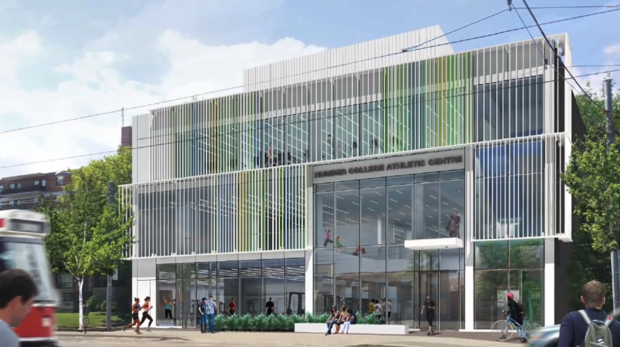

Humber grows green
Archive 2015 Apr 22, 2015 Kyle Wyskiel

You may have spotted the deadfall of recently cut down trees and cleared field on the corner of Kipling and Lakeshore and before you raise your arms in protest, what’s being built there may not be hurting the environment as much as you think.
With construction underway on Humber Lakeshore’s new Welcome and Fitness Centres the buildings will be designed according to LEED Canada’s silver standard rating, a system put in place to measure the environmental impact of buildings and how green they really are. So how green is Humber?
“Humber has set a minimum standard that all of our buildings would be at the LEED Silver standard although some buildings might be greater,” says Humber Lakeshore principal Wanda Buote. “Sustainability is built into our strategic plan and those principals and every time we approach a project, it’s with that lens.”
Well to start, all of Humber’s buildings are designed to a minimum of LEED silver standard and while there are also gold and platinum levels that could have been attained, there are a variety of factors that weigh in on how green Humber’s buildings are. But what is LEED and how does it work?
“The point of LEED is to transform the built environment, it’s a voluntary rating system that’s been in use in Canada since 2002, it’s an international benchmark for green building that’s used in 150 countries,” says Sarah Miller the Client and Member Services Operator at the Canadian Green building Council in Ottawa. “It really is about reducing environmental impacts from buildings.”
The voluntary rating system has been in use in Canada for 13 years now and in that time has cut down on construction waste and has led to better, greener buildings that produce less greenhouse gases and save money.
“Generally speaking LEED buildings consume less energy, they create less greenhouse gases, they keep waste out of landfills and they also provide a better return on investment in many cases as well.” Says Miller. “Since 2005 for example LEED certified projects have recycled over 2 million tons of construction demolition waste and we’ve had water savings totaling over 3.3 billion litres.”
As for what’s to be included in Humber’s buildings and those trees that have been lost to construction well, here’s what going to happen.
“One of the components we’re including is putting on a green roof and also because we had to take some trees down to build, we took 18 trees down, we’re putting 24 trees back onto the place and then we’re going to plant 30 more trees into Sam Smith Park and as well we’re going to plant 12 trees at a local high school that doesn’t have any trees, St. Leo’s Catholic school.” Says Buote.
So the trees will be back. But in order to accomplish the silver standard, something that has to be reviewed after the completion of the building to see if it holds up, there is much more that has to be accounted for. After all, the buildings can’t be certified by LEED unless they meet the required parameters on energy and conservation.
“The energy is the biggest opportunity to earn points but it is only one of eight categories,” says Kerry Johnston, the Sustainable Energy and Building Technology Program Manager at Humber College. “So energy is important but it’s also the water efficiency and the materials and the resources so earning points by using locally sourced material and making sure all of your stuff is recycled.”
As for the point system, the Welcome and Fitness Centres have to score between 50-59 points on its review. Of the categories, those points come from things like materials and resources, location and transportation, indoor environmental qualities, water efficiency, energy and atmosphere, sustainable sites, regional priority and innovation. But while all of these aspects count for something and lead to a better, greener building during and after construction, some of the pitfalls of the LEED rating system is that your building may not function that way after the review.
“One of the knocks about the LEED rating system is that it is basically something that happens at a point in time and there’s not really a guarantee that you’re going to maintain the building the way you did when you got the rating.” Says Johnston.
“Like we have a LEED Gold building at the North Campus, the Centre for Urban Ecology and that was opened around 2007 and it achieved the LEED Gold rating but there’s nothing in that rating that really requires you to continue to maintain that status. That’s one of the criticisms of the LEED standard, that it’s a point in time and are you going to continue to operate the building the way it should be?”
But if well maintained, something Humber is adamant about doing, energy savings and the environment all stand to gain. Generally buildings built and owned by the same institution, like in Humber’s case, function to the LEED standard after the review more often as they have a stake in how it runs.
“Our goal is to really be efficient so we’re building to the LEED standard for construction standard, we want to make sure the building is economical in the future and sustainable as much as possible,” says Buote. “We’ll be looking at things as far as water efficiency, heating efficiency, even indoor environmental qualities, those kinds of things will be built into the plan.”
As construction continues on the new buildings students can look forward to having all new centres to stay fit and get counseling and financial services. As for that empty patch of torn up land, an eye sore to some, what’s coming will be brand new energy efficient buildings aimed at saving not only the wallets of Humber and its students, but also the environment. Construction on the new buildings is set to be complete sometime this year.






